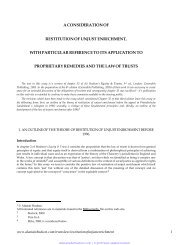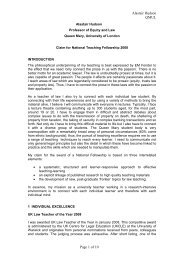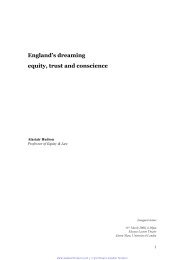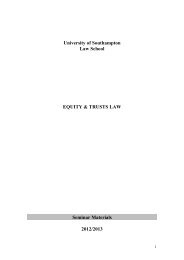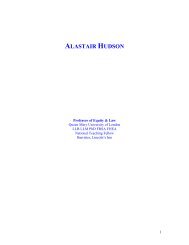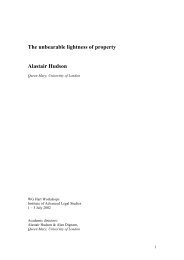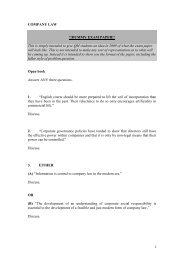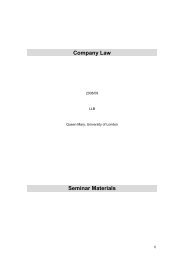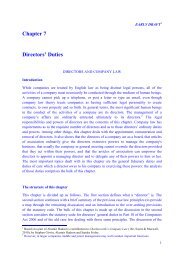Advanced Equity and Trusts Law - alastairhudson.com
Advanced Equity and Trusts Law - alastairhudson.com
Advanced Equity and Trusts Law - alastairhudson.com
Create successful ePaper yourself
Turn your PDF publications into a flip-book with our unique Google optimized e-Paper software.
developed in relation to traditional trusts which are applicable only to such trusts <strong>and</strong> the rationale of which has no<br />
application to trust of quite a different kind.’<br />
3) Loss as the foundation for the claim<br />
Target Holdings v. Redferns [1996] 1 AC 421<br />
Re Massingberd’s Settlement (1890) 63 LT 296<br />
4) Loss in relation to investment<br />
Nestle v National Westminster Bank plc (No 2)[1993] 1 WLR 1260, [1994] 1 All ER 118<br />
(C) Remedies for breach of trust.<br />
Reading: Hudson, section 18.3<br />
**Target Holdings v. Redferns [1996] 1 AC 421, [1995] 3 All ER 785 HL per Lord Browne-<br />
Wilkinson:-<br />
‘Courts of <strong>Equity</strong> did not award damages but, acting in personam, ordered the defaulting trustee to restore the trust<br />
estate. If specific restitution of the trust property is not possible, the liability of the trustee is to pay sufficient<br />
<strong>com</strong>pensation to the trust estate to put it back to what it would have been had the breach not been <strong>com</strong>mitted. Even<br />
if the immediate cause of the loss is the dishonesty or failure of a third party, the trustee is liable to make good that<br />
loss to the trust estate if, but for the breach, such loss would not have occurred. Thus the <strong>com</strong>mon law rules of<br />
remoteness of damage <strong>and</strong> causation do not apply. However, there does have to be some causal connection between<br />
the breach of trust <strong>and</strong> the loss to the trust estate for which <strong>com</strong>pensation is recoverable, viz the fact that the loss<br />
would not have occurred but for the breach.’<br />
There are therefore three forms of remedy here:<br />
� proprietary obligation,<br />
� obligation to restore trust fund,<br />
� <strong>com</strong>pensation.<br />
(D) Defences to breach of trust.<br />
Reading: Hudson, section 18.4<br />
1) Lack of a causal link between breach <strong>and</strong> loss<br />
Target Holdings v. Redferns [1996] 1 AC 421<br />
2) Breach <strong>com</strong>mitted by another trustee<br />
Townley v Sherborne (1633) Bridg 35; (1633) W & TLC 577.<br />
Brice v Stokes (1805) 11 Ves Jr 319<br />
3) Failure by beneficiary to alleviate loss<br />
Nacional del Cobre de Chile v Sogemin Metals Ltd [1997] 1 WLR 1396<br />
4) Release<br />
Lyall v Edwards (1861) 6 H & N 337; (1861) 158 ER 139<br />
BCCI v Ali [2000] 3 All ER 51<br />
5) Trustee exemption clause<br />
Armitage v Nurse [1998] Ch 241<br />
Bogg v Raper (1998) The Times, 12 April<br />
Wight v Olswang [2000] WTLR 783<br />
Walker v Stones [2001] QB 902<br />
6) Excuses for breach of trust<br />
www.<strong>alastairhudson</strong>.<strong>com</strong> | © professor alastair hudson<br />
30



